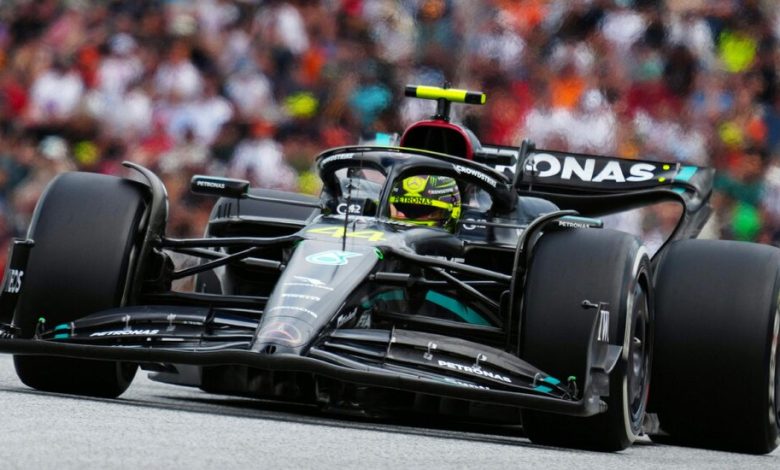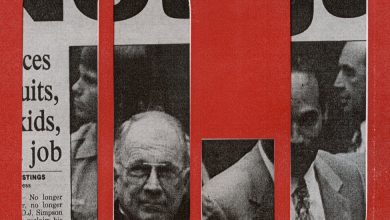Mercedes Performance Improves After Adjustments to Its Racecar

After qualifying was finished for the season-opening Bahrain Grand Prix in March, Toto Wolff, the Mercedes team principal, condemned his own car.
Lewis Hamilton and George Russell, the team’s drivers, had finished over six-tenths of a second behind the leading time set by the reigning champion, Max Verstappen of Red Bull, which is a huge gap in Formula 1.
“We got the physics wrong, and now we need to correct it,” Wolff said. “We gave it our best go, and now we need to regroup, sit down with the engineers and decide the development direction we want to pursue in order to win races.
“We hit our targets, and that showed us that it is simply not good enough.”
Weeks later, at the Monaco Grand Prix, Mercedes introduced an upgraded version of its W14 car. With new side pods, the aerodynamic shape was different. There was also a new floor and front suspension.
The performance of the car has improved. Hamilton and Russell finished second and third in the next race in Spain, the team’s first double finish on the podium this year. Hamilton was also third in Canada.
For this weekend’s British Grand Prix at Silverstone, there will be a new front wing.
Wolff’s words in Bahrain underlined the gravity of the team’s situation a year after the introduction of new aerodynamic regulations last season, during which the team won only once.
“It’s not a very mystical process,” James Allison, the team’s technical director, said in an interview about the changes to the car. “It’s nigh-on identical as to what happens whether the boss makes a comment like that or he says nothing at all. It’s all set out quite a long time in advance.
“At the beginning of the year, long before we know whether the car is good, bad or indifferent, we will have hypothecated an amount of our budget and an amount of our people’s time, once the car is rolling, for the in-season upgrade fight.”
The floor and front wing, he said, were “planned before the car turned a wheel,” while there was a range of bodywork options he described as “background tasks” under assessment via computational fluid dynamics, a digital form of aerodynamic analysis.
“The thing that changed as a result of the car turning a wheel was the suspension,” Allison said. “It wasn’t a planned upgrade, because normally you wouldn’t mess around with that during a season because it’s complicated, but we felt like it would be a good investment.”
The trigger for making such a fundamental change to the car was a greater appreciation of the regulations following a season when Mercedes was “a bit up to our eyeballs in bouncing,” Allison said.
A byproduct of the rules that were designed to aid overtaking and make the races more exciting, was porpoising, a violent up-and-down movement caused by the stalling of airflow underneath the car. Mercedes struggled more than most.
“This generation of car is not very nice to drive compared with the older cars, which had got to a very refined state,” Allison said. “Because it’s near to the ground, so stiffly sprung and with this big front wing on it, they are a bit of a handful.”
Mercedes felt it could make its existing suspension work with the aerodynamics, but its focus was diverted while attempting to solve the porpoising.
Once the team fixed that, it then focused on other areas of the car, leading to the suspension change and introduced an antidive system, Allison said, which reduces the front dive of a car under braking.
“That was something we could and should have done sooner,” he said. “This year, with the car tamer and its underlying behavior more obvious, we were then able to look at it and do something.”
After his performance in the Spanish Grand Prix, Hamilton, a seven-time champion, said the car was “the best it has been for the last year and a half,” and the team again has “its North Star.”
“We know where we need to go,” he said. “We don’t know everything about how to get there, but we know that together we can get there if we just keep our heads down and focus on the science.”
But there are limitations as to how quickly a car can be developed.
In 2021, Formula 1 introduced the budget cap designed to make the teams more equal and ensure that Mercedes, Ferrari and Red Bull could no longer spend unchecked on developing their cars. After a cap of $145 million that year, this season it is $135 million.
Rob Thomas, chief operating officer of Mercedes, said the team “was never wasteful,” but the budget cap has made the entire organization more mindful of costs.
“One of the things we had to look at was how many parts we actually made,” Thomas said in an interview. “It gets quite complicated when you think of the many thousands of parts on a car.
“We’ve had to get a lot sharper because we have found out we weren’t as efficient as we thought we were. It’s made us look hard at it.”
Taking the floor of a car as an example, he said wear and tear would have resulted in the entire component being replaced in the past. Not now.
“We’ve been smarter working with the engineers, saying ‘Which parts of the floor actually wear?’, so our design is such that we can replace certain parts of the floor as opposed to the whole thing,” he said.
The budget cap has also reduced the number of spare parts the team takes to a Grand Prix.
“What we take to a circuit now we would never have done so three years ago because we were too scared,” Thomas said.
“What happens if the two cars have an incident and you haven’t got a spare. You’re in trouble. But we’ve got more confident in our processes.”
Allison said Mercedes was now more discriminating.
“There’s a higher bar for a part to clear before we’ll spend cash on it,” he said.
“A front wing doesn’t cost less than a front wing used to cost, but it’s now about the number of iterations we’ll do in a year and then, when we do an iteration, how few we dare do means the inventory cost comes down.”
Even with an improved car, it will continue to be updated during the season. At the same time, the team will be increasing its development plans for next year’s car, the W15.
“The plan for when you start winding down this car and winding up the next one, a first guess of that plan was in place long before the car ran,” Allison said about the W14. “And then depending on what battle you’re fighting, you’ll skew that plan one way or the other.”



